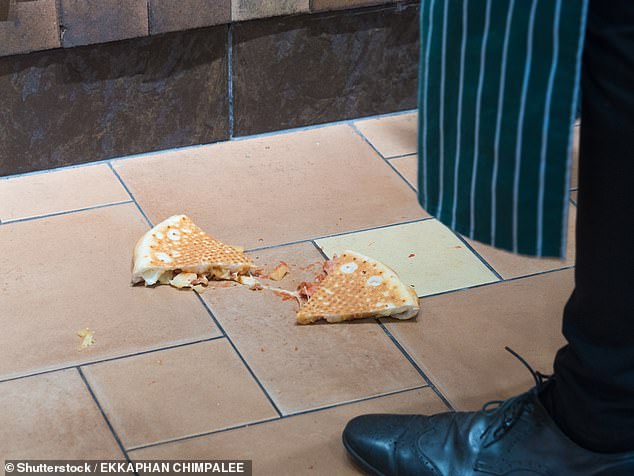It’s a rumour that has circulated in school canteens around the world for years.
The so-called ‘5-second rule’ is the idea that it’s safe to eat food dropped on the floor if picked up within five seconds.
So, is there any truth to this rule?
TikToker @HowDirtyIs set out to settle the debate once and for all – and it’s bad news if you’ve been living by the five-second rule.
The scientist dropped a petri dish onto a surface for varying lengths of time, ranging from 0 seconds to one minute.
They then placed the samples in a fridge to cool, until the results become clear.
Disgustingly, the petri dish had hundreds of colonies of bacteria after just five seconds on the surface.
‘5 seconds or 60, it’ll be nasty either way,’ @HowDirtyIs said.

The so-called ‘5-second rule’ is the idea that it’s safe to eat food dropped on the floor if picked up within five seconds (stock image)
The true origin of the 5-second rule is a mystery.
Some people believe it originated with the Mongol ruler and tyrant Ghengis Khan, who demanded people still eat food that fell on the floor during his banquets.
Others attribute it to Julia Child’s cooking show in the 1960s when she picked up a pancake that fell on the stove and told her viewers it was still okay to eat.
Either way, @HowDirtyIs was determined to find out whether there was any truth to it.
After just a brief drop (deemed ‘0 seconds’ by the TikToker), the petri dish was covered in hundreds of bacteria colonies.
‘Looks like even 0 seconds is too long,’ they said.
The dishes that had been dropped for 5-20 seconds looked very similar – but things really started to ramp up from there.
After 30 seconds, the dish had grown a huge colony, dubbed the ‘big boy’ by @HowDirtyIs.

The scientist dropped a petri dish onto a surface for varying lengths of time, ranging from 0 seconds to one minute (stock image)
Viewers were split in the comments, with some calling the findings ‘nasty’.
‘Only Americans believe this rule. Ain’t no way actual adults could believe it’s not nasty,’ one user commented.
Another wrote: ‘Never eating food from the floor again…’
And one joked: ‘bro ruined my spaghetti.’
However, other viewers were undeterred, including one who called the bacteria ‘extra flavour’.
‘Meh. I was doing the 5 second rule throughout my childhood and I’m still healthy,’ one user said.
Another added: ‘I once ate a handful of chocolate chips one by one off the floor, I was fine.’







